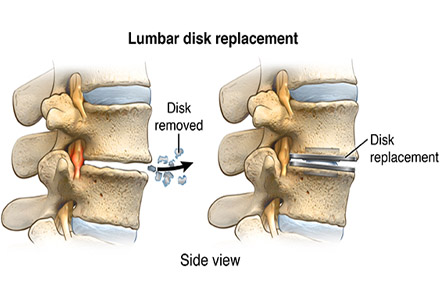Lumbar Disc Replacement
Introduction
Spinal intervertebral disk is a joint between bodies (anterior part of vertebra) of adjacent vertebrae. Spinal disk degeneration is a common disease typically in lumbar or low back region. It is also the most common cause of low back pain causing limitation of spine movements and decreasing the quality of life of patients. Total disc replacement (TDR, also called artificial disc) surgery is one of the recent advancements in spine surgery. This surgery is recommended only after a thorough conservative management has failed to reduce the symptoms.
Artificial intervertebral discs act as a functional prosthetic replacement unit for intervertebral disk joint in similar way to the prostheses for variety of joints such as the hip or knee.
Candidate for Disk Replacement
To determine the suitability for disk replacement, the surgeon can order a few investigations such as magnetic resonance imaging (MRI) of the spine, discography, computed tomography scan, and x-rays. These tests can guide the surgeon towards the source of the pain.
We have all the information you need about public and private clinics and hospitals that provide spinal surgery in Iran, Islamic Republic Of with the best quality and lowest possible prices

Good candidates for disk replacement should have the following requirements
1. Severe low back pain in patients who have received at least 6 months of conservative treatment with no relief of treatment.
2. One or two lumbar intervertebral disks are involved in degeneration.
3. No significant facet joint disease or compression on nerves by bone.
4. Vertebrae have not moved more than 3mm in MRI scan.
5. No deformity of spine like kyphosis or scoliosis.
6. No previous major surgery on spine.
7. Not excessively overweight patient.
Benefits of Lumbar Disc Replacement
1. Most important benefit is relief of back pain and improvement of movements of spine.
2. The Artificial Disc design is postulated to increase the flexibility and mobility during bending forward and backward movements more than that allowed by spinal fusion surgery.
3. No bone graft is required and hence the recovery time is time.
Recovery from lumbar disc replacement can vary among the patients and is dependent age.
Artificial Disc Surgery is not suitable for patients who have a systemic infection or local spine infection, having disc degeneration at more than two spinal levels, or who having poor bone quality as in case of osteoporosis or osteopenia.
The device
The Artificial Disc is a three-piece medical device consisting of a sliding core encased between two metal plates. The materials used for this prosthesis are medical grade plastic and medical grade cobalt chromium alloy. The metal endplates support the sliding core by gripping them to the vertebrae above and below the disc space with small teeth or clasps. It has a lifespan of about 40 years.
Before Lumbar Disc Replacement
The surgeon usually does or advices following things:
1. A proper history, physical examination and few blood tests and scans are done to determine the general health.
2. A neurological examination is important before the procedure.
3. Make sure the disk prosthesis is ordered before the surgery and is sterilized properly on a day before the surgery.
4. Patient should stop anti-inflammatory drugs like aspirin at least a week before surgery.
5. Medications being taken for other conditions like diabetes, heart disease, blood pressure should be continued with advice from the treating doctor.
6. History of smoking or alcohol drinking should be told to the surgeon. Smoking should be stopped if possible as it interferes with the wound healing.
7. Recent history of cough, cold, fever, viral infections, or other illnesses should be informed to the surgeon.
8. Patient is not allowed to eat or drink anything at least 8 to 12 hours before surgery except essential medicines with sips of water.
9. Prior to surgery, the patient is asked to sign the consent for surgery, anesthesia, blood and blood products.
What to Expect During Lumbar Disc Replacement
1. This surgery takes about 1 to 3 hours
2. After giving general anesthesia, the surgeon makes an incision in the abdomen to expose the front part of the spine.
3. Continuous fluoroscopic (live X-ray) guidance is used to determine the correct level to be operated.
4. The abdominal contents and major blood vessels are retracted to a side and the disk is approached.
5. The disk is removed and the replacement device is implanted.
6. Normal compression of the spine will hold the implant in place.
After Lumbar Disc Replacement
1. Patient is monitored in recovery room for at least one hour.
2. 2 or 3 intravenous lines are present to give fluids and medications.
3. Then, the patient is taken to hospital room. The hospital stay is usually of 1-2 days.
4. A lumbar brace is given to prevent excessive bending for several weeks.
5. This is followed by a detailed physiotherapy at home.
Recovery from lumbar disc replacement can vary among the patients and is dependent age, general health and the extent of the surgery and proper physiotherapy.